
Alfred Dolge
« « « «This book is for all those who are aficionados of old pianos. It contains snapshot sketches and pictures of the patriarchs of piano building. What struck me most strongly about this collection of mini biographies was that the lives of many of the great piano makers followed a rags to riches path made possible by a lot of very hard work which often resulted in prematurely shortening their lives. A number of these people worked themselves to death, all so that we may appreciate the fruits of their labor. For every modern piano owes something to these pioneers.
This book offers a glimpse into times gone by, different more optimistic perspectives which preceded the First World War. While not a must read, this book is an important source book for information on certain names associated with pianos; the Steinways, Chickerings, Knabes, Bosendorfer, Ehrbar, the Ibachs, Irmlers, and Schiedmayers, the Rachals, Bluthner, Bechstein, Ronish, Isermann, Weishart, Patzschke, Weikert, Poehlmann, Broadwood and Brimsmead. Also covered are the careers and contributions of Erard, Pleyel, Wolff, Herz, Kriegelstein, Schwander and Herrburger as well as the Schroders, Becker, Beitepage, and Yamaha (called Yamaba here). Others of note are Gray, Hale, McPhail, the Lindemans, Schomacker, Burns, Hazelton, Fischer, Stieff, Gross, Kurtzmann, Briggs, the Voses, Haines and Weber.
All these men and more were either piano designers who founded families who carried on their business or makers of various piano parts, which as time went on, even in the 19th century were standardized to improve efficiencies of manufacture. Dolge himself had a major hand in this trend as a maker of soundboards and action parts in upstate New York for many piano manufacturers.
Among the many quaint curiosities contained in this book are notions of "progress" wherein it is somehow assumed that innovation in and of itself is necessarily better and that the entire industry should take note and follow suit. The Jenko keyboard is one of the more interesting ideas. This is an innovation more traumatic than the Microsoft split keyboard that was supposed to help eliminate carpal tunnel syndrome. It would have called for a radically different technique. Other innovations were picked up by one or two piano makers, such as Richard Gertz's Tension Resonator which is an integral part of every Mason & Hamlin grand to this day.
Dolge left his mark on the piano industry and this book, complete with numerous illustrations is a trove of curious information that should form part of the education of everyone who is serious about pianos.
